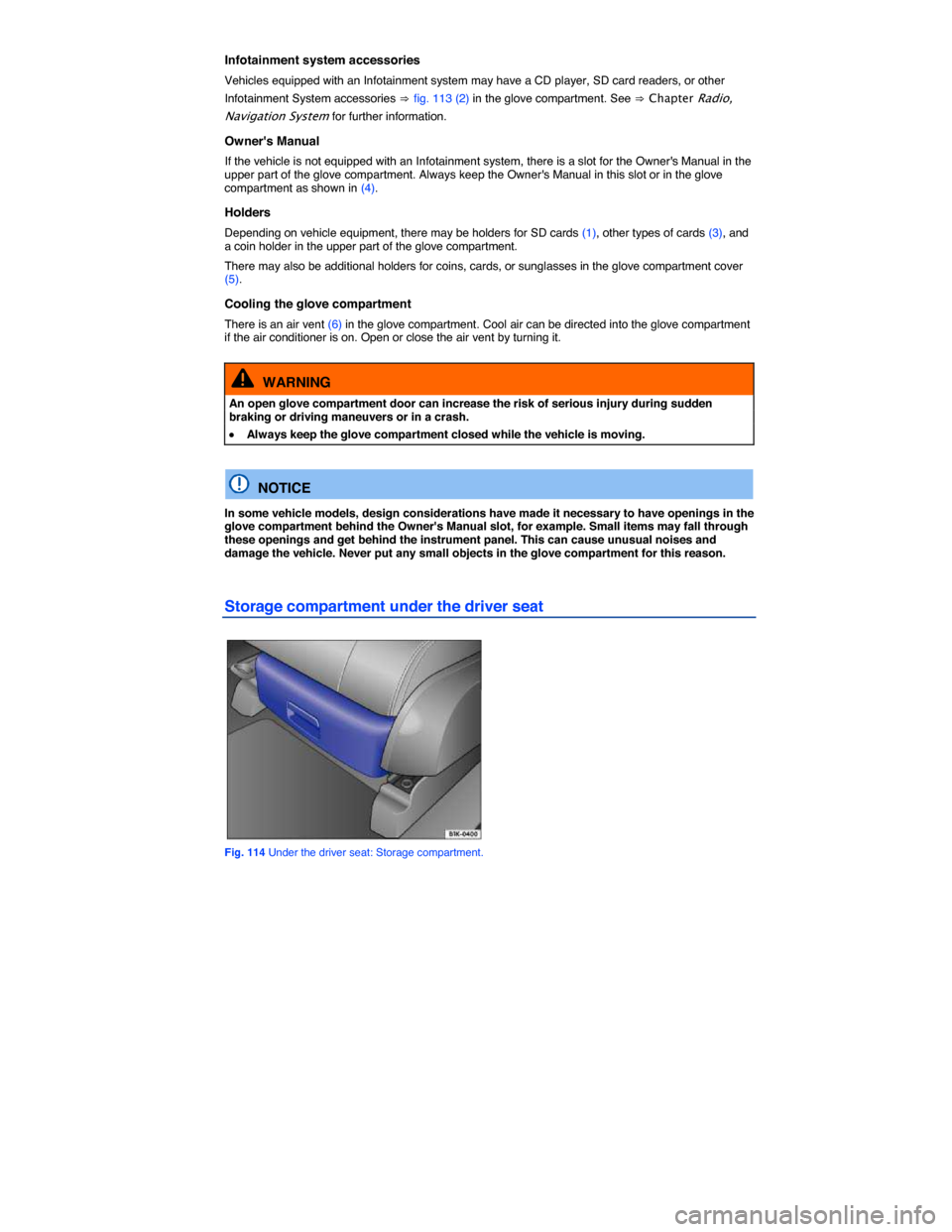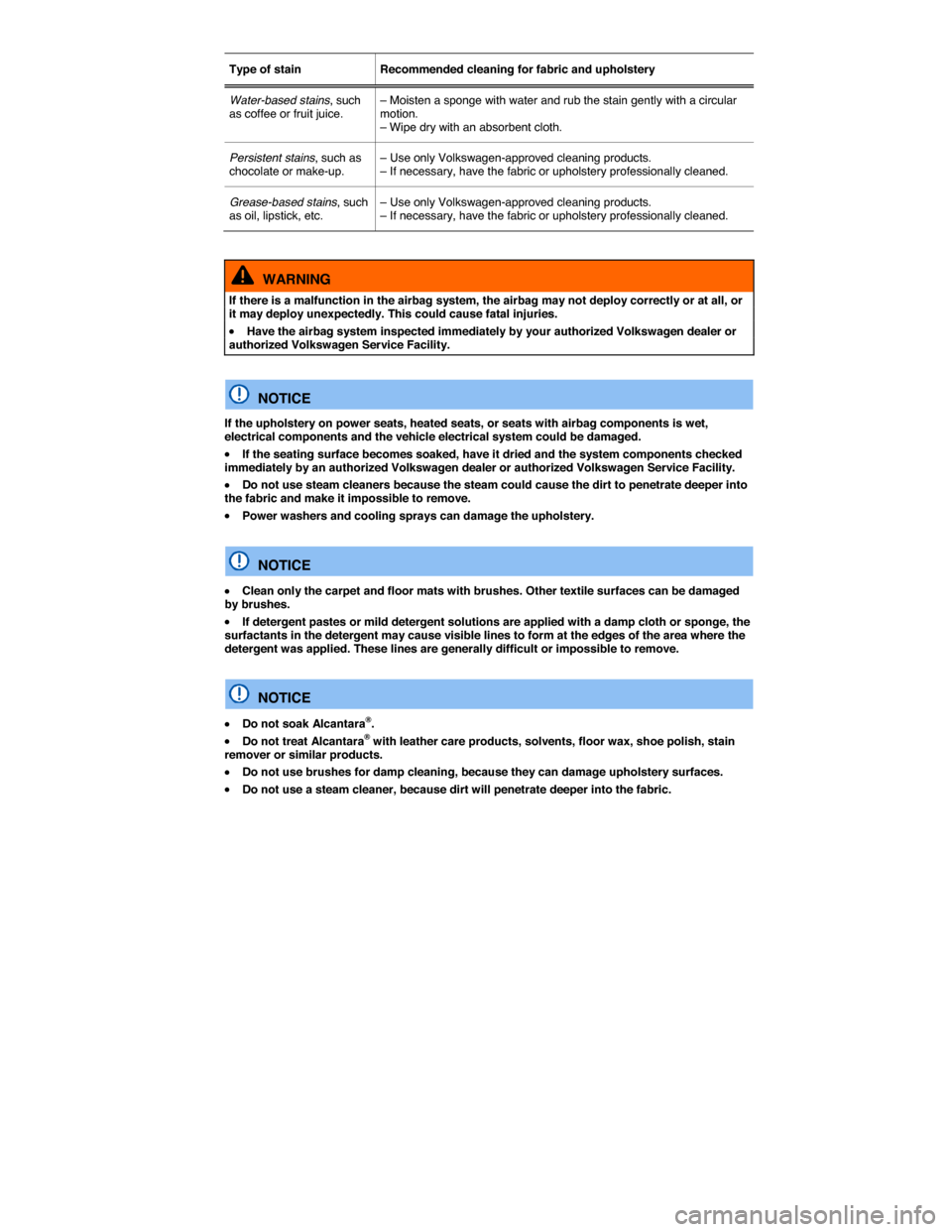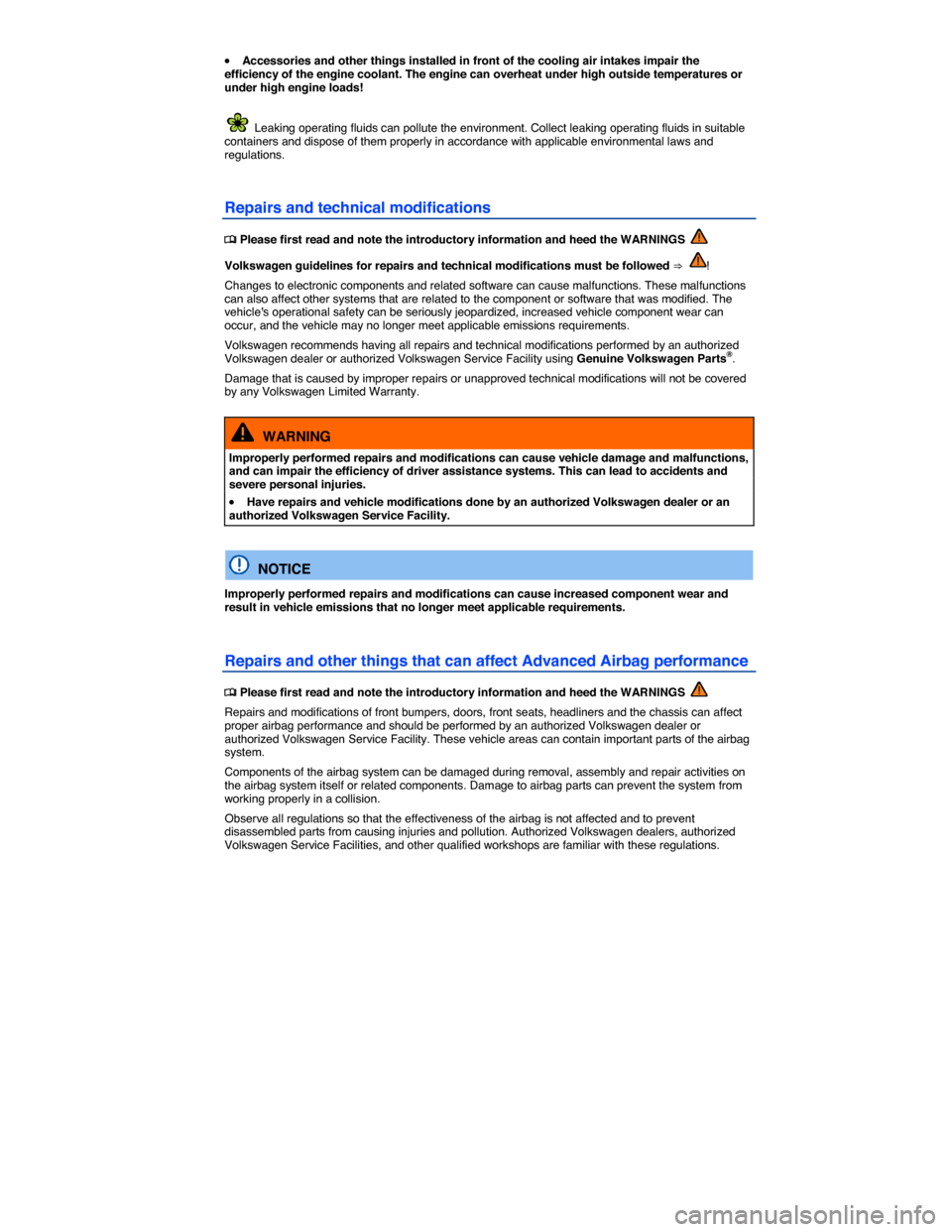2015 VOLKSWAGEN GOLF GTI cooling
[x] Cancel search: coolingPage 151 of 402

Do not use a bumper-mounted trailer hitch
Never install a trailer hitch on the bumper or on the bumper attachments. The trailer hitch must not interfere with the impact-absorbing bumper system. Do not make any changes to the vehicle exhaust and brake systems. From time to time, check that all trailer hitch mounting bolts are securely fastened. When you are not towing, remove the trailer hitch. This helps keep the trailer hitch from causing dam-age if your vehicle is hit from behind.
Engine cooling system
Towing a trailer makes the engine and its cooling system work harder. It is important that the engine cooling system is up to the job. Make sure that the cooling system has enough coolant.
Trailer brakes
If your trailer has its own brakes, make sure it meets all regulations. The trailer brake system must never be directly connected to the vehicle's brake system.
Safety chains
Always use safety chains between your vehicle and the trailer ⇒ Hitching up and connecting a trailer.
Trailer taillights
Trailer lights must meet all regulations ⇒ Hitching up and connecting a trailer.
Never connect the trailer lights directly to the electrical system of your vehicle.
Outside mirrors
If you cannot see the traffic behind you using the regular outside mirrors, then you must install extend-ed mirrors. Extended mirrors may also be required by law in some countries/states/provinces. Always adjust the outside mirrors before driving. It's vital that you always have a clear view to the rear of the vehicle.
Maximum power consumption for the trailer
Do not exceed the power ratings listed in the chart below.
Electrical load Maximum power
Brake lights total 108 watts
Turn signals per side 54 watts
Side marker lights total 100 watts
Taillights total 54 watts
WARNING
�x An improperly installed or incorrect trailer hitch can cause a trailer to separate from the tow vehicle and cause serious personal injuries.
�x If you don't have to tow a trailer any more, remove the entire trailer hitch. Always seal all bolt holes to prevent water and deadly exhaust fumes from getting into the vehicle.
Page 200 of 402

Infotainment system accessories
Vehicles equipped with an Infotainment system may have a CD player, SD card readers, or other
Infotainment System accessories ⇒ fig. 113 (2) in the glove compartment. See ⇒ Chapter Radio,
Navigation System for further information.
Owner's Manual
If the vehicle is not equipped with an Infotainment system, there is a slot for the Owner's Manual in the upper part of the glove compartment. Always keep the Owner's Manual in this slot or in the glove compartment as shown in (4).
Holders
Depending on vehicle equipment, there may be holders for SD cards (1), other types of cards (3), and a coin holder in the upper part of the glove compartment.
There may also be additional holders for coins, cards, or sunglasses in the glove compartment cover (5).
Cooling the glove compartment
There is an air vent (6) in the glove compartment. Cool air can be directed into the glove compartment if the air conditioner is on. Open or close the air vent by turning it.
WARNING
An open glove compartment door can increase the risk of serious injury during sudden braking or driving maneuvers or in a crash.
�x Always keep the glove compartment closed while the vehicle is moving.
NOTICE
In some vehicle models, design considerations have made it necessary to have openings in the glove compartment behind the Owner's Manual slot, for example. Small items may fall through these openings and get behind the instrument panel. This can cause unusual noises and damage the vehicle. Never put any small objects in the glove compartment for this reason.
Storage compartment under the driver seat
Fig. 114 Under the driver seat: Storage compartment.
Page 313 of 402

To protect the engine, the mixture must always contain at least 40% coolant additive even in warm weather or climates where antifreeze protection is not needed.
If more antifreeze protection is needed for climate conditions, the percentage of coolant additive can be increased. However, the coolant additive percentage must never be more than 60%; otherwise, antifreeze protection is reduced and the ability of the mixture to cool the engine is also reduced.
When adding engine coolant, use a mixture of distilled water and at least 40% coolant additive G 13
or G 12 plus-plus (TL-VW 774 G) for optimum corrosion protection ⇒ .
Do not mix G 13 with G 12 plus or G 11. Mixing these coolant additives together significantly reduces
corrosion protection ⇒ and can lead to engine damage that is not covered by any Volkswagen Limited Warranty.
WARNING
Too little antifreeze protection in the engine cooling system can cause engine failure and severe injuries.
�x Always make sure there is enough of the correct coolant additive to provide proper antifreeze protection at the coldest temperatures that can be expected where the vehicle will be used.
�x At extremely cold temperatures, the coolant could freeze, causing the vehicle to break down. The heater would also not work, and vehicle occupants could be without protection at subfreezing temperatures.
NOTICE
Never mix original Volkswagen engine coolant additives with other additives not approved by Volkswagen. Mixing Volkswagen coolant additives with coolant additives made by other manufacturers can seriously damage the engine and the engine cooling system.
�x If the fluid in the engine coolant reservoir is any color but pink, then G 13 was mixed with a different engine coolant. If this is the case, the engine coolant must be replaced immediately. Otherwise serious malfunctions or engine damage can occur!
Engine coolant and engine coolant additives can pollute the environment. Collect leaking operating fluids and dispose of them properly in accordance with applicable environmental laws and regulations.
Page 316 of 402

NOTICE
�x Use distilled water only when adding coolant! All other types of water contain chemical compounds that can cause extensive corrosion damage to the engine. This can even lead to engine failure. If you have added non-distilled water, take the vehicle immediately to an authorized Volkswagen dealer or an authorized Volkswagen Service Facility to have the coolant system drained, flushed, and refilled completely with the proper coolant.
�x Refill engine coolant only up to the top edge of the marked fill range . Excess engine coolant may be forced out of the engine cooling system when it gets hot and cause damage.
�x In the case of significant engine coolant loss, refill engine coolant only when the engine is completely cooled down. Significant engine coolant loss is a sign of leaks in the cooling system. Have the engine cooling system checked immediately by an authorized Volkswagen dealer or an authorized Volkswagen Service Facility. Otherwise the engine may be damaged!
�x Do not refill engine coolant if there is no coolant in the expansion tank. Air could enter the cooling system. Do not drive the vehicle! Seek expert assistance. Failure to do so can result in engine damage.
�x When changing or topping off operating fluids, make sure that you pour the fluids into the correct reservoirs. Serious malfunctions and engine damage can result if you pour operating fluids into the wrong reservoir.
Page 335 of 402

these seat surfaces and backrests can damage the vehicle electrical system and prevent the airbag
system from working properly ⇒ .
Electrical components and connectors that could be damaged by incorrect cleaning or handling are
installed in power seats and heated seats ⇒ . This can also result in damage to other parts of the vehicle electrical system.
For this reason, read and follow these cleaning instructions:
�x Do not use power washers, steam cleaners, or cooling spray.
�x Do not use detergent pastes or mild detergent solutions.
�x Do not wet the surface completely.
�x Only use cleaning products approved by Volkswagen.
�x If you have questions or concerns, consult a professional cleaner.
�x Before using any cleaning agent, familiarize yourself with instructions and warnings on the packaging.
�x Vacuum upholstery, fabric trim, Alcantara® upholstery, and carpeting regularly with a suitable brush attachment.
�x A soft sponge or a commercially available lint-free microfiber cloth may be used for general
cleaning ⇒ .
�x Clean Alcantara® surfaces with a damp cotton or wool cloth or a commercially available lint-free
microfiber cloth ⇒ .
Upholstery and fabric trim with light generalized soiling can be cleaned with a commercially available dry-foam cleaner.
If the upholstery and fabric trim pieces are heavily soiled, see your authorized Volkswagen dealer or authorized Volkswagen Service Facility before you begin cleaning to learn about suitable cleaning options. If necessary, have the cleaning done by a professional.
Cleaning upholstery on non-heated seats, manual seats, or seats without airbag components
�x Before using any cleaning agent, familiarize yourself with instructions and warnings on the packaging.
�x Vacuum upholstery, fabric trim, Alcantara® upholstery, and carpeting regularly with a suitable brush attachment.
�x Do not use power washers, steam cleaners, or cooling spray.
�x A soft sponge or a commercially available lint-free microfiber cloth may be used for general
cleaning ⇒ .
�x Clean Alcantara® surfaces with a damp cotton or wool cloth or a commercially available lint-free
microfiber cloth ⇒ .
Upholstery and fabric trim with light generalized soiling can be cleaned with a commercially available dry-foam cleaner.
If the upholstery and fabric trim pieces are heavily soiled, see your authorized Volkswagen dealer or authorized Volkswagen Service Facility before you begin cleaning to learn about suitable cleaning options. If necessary, have the cleaning done by a professional.
Treating stains
When treating stains, it may be necessary to clean the entire surface and not just the stain itself. This is especially true if the entire surface has become dirty from normal use. Otherwise, the area that is treated may become lighter than the untreated area. If you have questions or concerns, consult a professional cleaner.
Page 336 of 402

Type of stain Recommended cleaning for fabric and upholstery
Water-based stains, such as coffee or fruit juice. – Moisten a sponge with water and rub the stain gently with a circular motion. – Wipe dry with an absorbent cloth.
Persistent stains, such as chocolate or make-up. – Use only Volkswagen-approved cleaning products. – If necessary, have the fabric or upholstery professionally cleaned.
Grease-based stains, such as oil, lipstick, etc. – Use only Volkswagen-approved cleaning products. – If necessary, have the fabric or upholstery professionally cleaned.
WARNING
If there is a malfunction in the airbag system, the airbag may not deploy correctly or at all, or it may deploy unexpectedly. This could cause fatal injuries.
�x Have the airbag system inspected immediately by your authorized Volkswagen dealer or authorized Volkswagen Service Facility.
NOTICE
If the upholstery on power seats, heated seats, or seats with airbag components is wet, electrical components and the vehicle electrical system could be damaged.
�x If the seating surface becomes soaked, have it dried and the system components checked immediately by an authorized Volkswagen dealer or authorized Volkswagen Service Facility.
�x Do not use steam cleaners because the steam could cause the dirt to penetrate deeper into the fabric and make it impossible to remove.
�x Power washers and cooling sprays can damage the upholstery.
NOTICE
�x Clean only the carpet and floor mats with brushes. Other textile surfaces can be damaged by brushes.
�x If detergent pastes or mild detergent solutions are applied with a damp cloth or sponge, the surfactants in the detergent may cause visible lines to form at the edges of the area where the detergent was applied. These lines are generally difficult or impossible to remove.
NOTICE
�x Do not soak Alcantara®.
�x Do not treat Alcantara® with leather care products, solvents, floor wax, shoe polish, stain remover or similar products.
�x Do not use brushes for damp cleaning, because they can damage upholstery surfaces.
�x Do not use a steam cleaner, because dirt will penetrate deeper into the fabric.
Page 344 of 402

�x Accessories and other things installed in front of the cooling air intakes impair the efficiency of the engine coolant. The engine can overheat under high outside temperatures or under high engine loads!
Leaking operating fluids can pollute the environment. Collect leaking operating fluids in suitable containers and dispose of them properly in accordance with applicable environmental laws and regulations.
Repairs and technical modifications
�